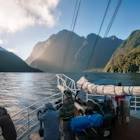
Wild, raw, brutally beautiful: trails in Australia that are ripe for bushwalking and running range from undulating, deceptively tough coastal routes to precipitous and remote highland adventures that demand self-sufficiency.

Bushwalking
Americans hike, the English ramble, Kiwis tramp, but Australians bushwalk. And what a lot of bush there is to walk: 4% of Australia is protected in national parks, covering 280,000 sq km (an area larger than England) and spanning the vast spectral spaces of the deserts to the ancient Gondwanan forests of Tasmania and the low alpine terrain of the Great Dividing Range. The ancient, worn-down topography of Australia lacks really big mountain ranges, but it has everything else: a stunning, varied coastline, tropical and temperate rainforests, endless sand and gibber (stony) deserts, and iconic forests of eucalyptus. From short but spectacular day walks to long distance tracks like the Bibbulmun, there’s something for everyone, while Australia’s famous wildlife – from bounding kangaroos to incredible birdlife – is never far off.
Read more: Surf-ski, kayak, SUP and whitewater: the best places to paddle in Australia

Tasmania
Often left off maps of Australia, Tasmania is not a place easily forgotten by bushwalkers. This small compact island, parted from the mainland some 12,000 years ago, holds epic bushwalking terrain. Most famous is the Overland Track, a 65km walk through the Cradle Mountain–Lake St Clair National Park. The rutted, muddy track is almost a rite of passage, leading walkers through a prehistoric landscape of Gondwanan myrtle-beech forests, buttongrass plains and alpine herb fields, all overlooked by spectacular dolerite sentinels.
Further south, in the Southwest National Park, the wilderness is possibly even more rugged and untamed. For our money, the South Coast Track is the pick of the hikes here (although the Western Arthurs traverse is more famous). Hikers are dropped off by prop plane at Melaleuca, then slowly walk back east along the famously muddy track, climbing the windswept heights of the Ironbound Range and passing a succession of pristine, deserted beachside campsites before reaching civilisation at Cockle Creek 84km later.
Read more: Rock climbing in Australia: where to find the best routes and pitches

Central Australia
West of Alice Springs in Central Australia is the West MacDonnell Ranges, a series of spectacular mountains poking out of the desert landscape like the exposed spine of a fossilised dinosaur. Traversing this arid landscape is one of Australia’s most unique walks, the 223km Larapinta Trail. It links razor-sharp ridges, dry riverbeds lined by gnarled gums, spectacular chasms and hidden oases of water and ferns – remnants of wetter epochs – all the way west to Mt Sonder. The landscape is harsh but beautiful, and as you pass through it you begin to appreciate the ingenuity of the local Arrernte people who have inhabited the area for 50,000 years.
Read more: Surf Australia: where to find the best breaks

Western Australia
Just east of Perth in Western Australia, the small town of Kalamunda marks the start of the Bibbulmun Track, a bushwalk that travels 1003km south to finish in Albany. Considered one of the world’s great long-distance walks, the Bibbulmun takes walkers through the heart of the southwest, passing by giant granite boulders, towering karri and tingle forest, and coastal heathlands. While there are many ‘end-to-enders’, it’s most often tackled in shorter sections.
Read more: The best places to mountain bike in Australia

The south and east coast
The epic arc of the Great Dividing Range stretches for 3500km down the east coast of Australia, and in the folds of its dramatic topography there are many lifetimes of walking to be done. Forty-five national parks protect the range, many beloved of bushwalkers. The most popular is the Blue Mountains National Park, just west of Sydney, where the steep, cliff-lined valleys hold everything from short, spectacular day walks to multiday off-track adventures deep in the park.
Further south, the Australian Alps, often snow-covered in winter, is another classic bushwalking destination, famed for its multiday hikes. In New South Wales hikers regularly climb Australia’s highest peak, the modest Mt Kosciuszko (2228m). Further south in Victoria, linking the spectacular ridgelines of the Razorback and Mt Feathertop is a bushwalking favourite that can either be done as a day walk or linked into a longer multiday walk.
Read more: Why Atherton Tablelands is one of Australia's best-kept natural secrets

Trail running
Australia has undergone a trail running boom in the past decade, energised by high-profile festivals such as Ultra Trail Australia, which attracts 2000 competitors annually. Held in the Blue Mountains National Park, near Sydney in New South Wales, it uses highlight sections of the 44km Six Foot Track, which itself is host to another eponymous end-to-end outing considered an elder statesman of the now brimful event calendar.
Away from events, long-distance gazetted routes are key targets and include the Great Ocean Walk (100km, Victoria), Cape to Cape (135km, Western Australia), Overland Track (82km, Tasmania) and, for an epic arid desert experience, the 223km Larapinta Trail in the Northern Territory. A rural trail running hub of note is Bright, Victoria, where runners can pick up trails from the centre of town, leading to some of the biggest hill climbs going.
Read more: 10 epic ultra running races that are worth the effort
For those bound to metro areas, try Melbourne’s Yarra River Trails, barely 3km from the CBD; or myriad wild routes through Royal National Park, right on Sydney’s doorstep. The South Australian capital has the Adelaide Hills; Tasmania’s capital, Hobart, features trail-striped Mt Wellington (1271m) as its backdrop – try the newly stitched 27km Kunanyi-Wellington loop, boasting 1300m of ascent – and Canberra is surrounded by singletrack.
Explore related stories





 Hiking8 dream trips to take in Australia, New Zealand and the South Pacific
Hiking8 dream trips to take in Australia, New Zealand and the South PacificJan 21, 2025 • 8 min read













